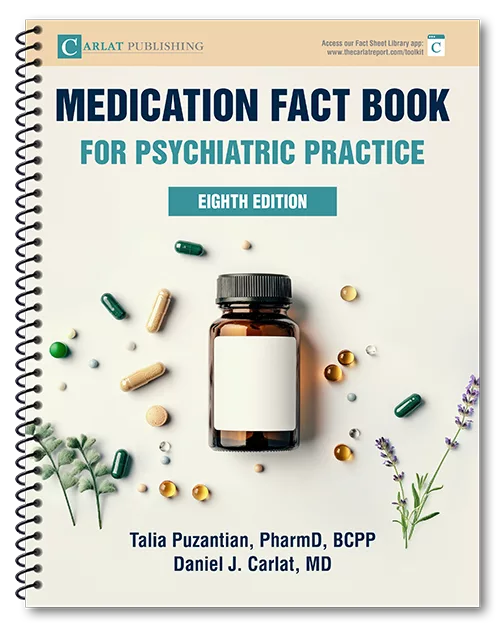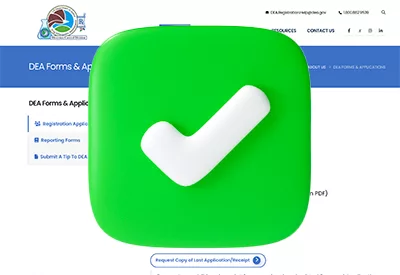The FDA just approved the cyclobenzaprine (Tonmya, Flexeril) for fibromyalgia. We look at three risks that medication raises in psychiatry.
Publication Date: 09/01/2025
Duration: 16 minutes, 42 seconds
Transcript:
KELLIE NEWSOME: The FDA just approved Tonmya for fibromyalgia, though you might know it as cyclobenzaprine or Flexeril. What you may not know is that it carries three serious risks for your patients and your license. Welcome to The Carlat Psychiatry Podcast, keeping psychiatry honest since 2003.
CHRIS AIKEN: I’m Chris Aiken, the editor in chief of the Carlat Report.
KELLIE NEWSOME: And I’m Kellie Newsome, a psychiatric NP and a dedicated reader of every issue. There are three FDA-approved medications for fibromyalgia, and the FDA just added a fourth. All of them have psychiatric risks and benefits, and today we’ll cover a new one: cyclobenzaprine, which was just approved as a sublingual form – branded Tonmya. Like we covered in our recent ketamine podcast, this is a secondary approval. New form, new use, new brand name. In terms of symptoms, it’s an important advance for patients – improving sleep and physical pain. But it carries three risks you need to know about. There are overdose deaths when combined with benzos or opioids, and the DEA is in hot pursuit of clinicians who prescribe those three together. It can cause mania and psychosis, and in the elderly, it may cause more trouble than it's worth.
CHRIS AIKEN: First, let's review past fibromyalgia approvals. It started with pregabalin (Lyrica) in 2007. Pregabalin may lack FDA approvals in psychiatry, but it is approved in Europe for Generalized Anxiety Disorder, and I’d recommend it there, here in the US as well. It is more effective than SSRIs and SNRIs in anxiety disorders, judging by effect size, and has better evidence than its gabapentinoid cousin, gabapentin, especially in GAD and social anxiety disorder, where pregabalin is dosed at 300-600 mg a day, usually all at night, with its ability to deepen sleep quality, pregabalin is preferred in fibromyalgia for patients with sleep problems and pain.
KELLIE NEWSOME: Next came two SNRI antidepressants - duloxetine (Cymbalta) in 2008 and milnacipran (Savella) in 2009. In psychiatry, duloxetine is approved for depression and generalized anxiety disorder, and that anxiety indication stretches all the way down to age 7. Outside the US, duloxetine is also approved for urine incontinence, and that reveals a pearl you need to know about this drug. It can make it more difficult to pee. Which is a good thing if you have incontinence, as many older adults do, but if you don’t, that can lead to urine retention and UTIs. Off-label, duloxetine improves binge eating and prevents migraines, and is one of the antidepressants with the most cognitive benefits, along with Vortioxetine and bupropion. Milnacipran has no psychiatric approvals in the US, but it does treat depression – it’s approved for that in France and Japan, and its isomer – levomilnacipran – is FDA approved as Fetzima in major depression.
CHRIS AIKEN: If you’ve not used levomilnacipran, you’re not alone. Its late entry into the field – 2013 – and its branded status have slowed its adoption. But consider it as a second-line after bupropion for patients who are lethargic, slowed down. The types that you'd use bupropion for, like bupropion, Levora is a slightly activating drug. It's the most noradrenergic of the SNRIs in the US. So, there was a rush of new approvals in fibromyalgia 15 years ago, all three of them in a two or three-year period, and here's how things stand with those three FDA-approved agents now. In fibromyalgia, pregabalin is preferred for patients with sleep problems, while the SNRIs are preferred for those with fatigue, depression, and anxiety. When patients have sleep problems and depression or anxiety, doctors often use low doses of Amitriptyline off-label, and Amitriptyline has a very similar structure to this new one, Cyclobenzaprine. Next, we'll look at where Cyclobenzaprine fits and the psychiatric risks that it brings.
KELLIE NEWSOME: After 2009, we saw no new approves for fibromyalgia, until August 15, 2025, when the FDA approved cyclobenzaprine. But cyclobenzaprine is not new at all. It was approved as a muscle relaxant – Flexeril – in 1977, the same year that fibromyalgia entered the medical lexicon. The first controlled trial of cyclobenzaprine in fibromyalgia came out in 1989, a year before the American College of Rheumatology released the first criteria for the disorder. As the 1990s progressed, cyclobenzaprine grew in popularity, and it remained one of the most commonly prescribed medications for fibromyalgia even as the other three gained FDA approval.
CHRIS AIKEN: In 2016, researchers looked at prescription patterns for a quarter of a million privately insured patients in the US with fibromyalgia. Even though it was off-label, cyclobenzaprine was the most commonly prescribed medication. 1 in 3 people with fibromyalgia took it, a rate that is 2-4 times higher than the approved options, possibly because the approved options were all brand-only back then. But the second most commonly prescribed treatment was an opioid with SNRI-like properties: Tramadol. Tramadol is not approved in fibromyalgia, but it is used off-label there, and it is recommended by the American College of Rheumatology.
KELLIE NEWSOME: That combination of an opioid – tramadol – with a muscle relaxant – cyclobenzaprine - highlights the first psychiatric risk with this new approval. Because when you add a benzodiazepine to that combo, you get what the DEA calls the “Holy Trinity” – an abusable combination of sedatives that is seriously raises the risk of respiratory depression and death. That risk is not as bad with cyclobenzaprine; the riskiest muscle relaxant is carisoprodol, aka Soma, because carisoprodol is metabolized into a barbiturate, so in that case, it’s no longer a trinity, it’s a quaternity: An opioid, a muscle relaxant, a barbiturate, and a benzo.
CHRIS AIKEN: So check for carisoprodol and opioids on the med list before prescribing a benzodiazepine, but watch out for cyclobenzaprine as well. It also raises the risk of respiratory suppression when combined with opioids, alcohol, or benzodiazepines. Pregabalin, gabapentin, antipsychotics, and psychostimulants also raise the overdose risk, though not as much as the muscle relaxants, and with the exception of the psycho stimulants, they're not as much on the DEA's radar. The US government has prosecuted doctors for prescribing the opioid-benzo combo along with other muscle relaxants like baclofen. On the juicy DEA web pages that detail these prosecutions, some of them define the Holy Trinity as an opioid, a benzo, and carisoprodol; while others use the more generic term “muscle relaxant.”, broading their radar. It’s tempting to criticize the government for this lack of precision, but if we’re going to go down that road, maybe we ought to call them out for keeping all this hidden. If this is such a danger to the public – and I do believe it is – why haven’t they put out a Dr. Doctor or Dear NP letter? If any of our listeners got one, please send it to me at caiken@thecarlatreport.com. These prosecutions took a harsher turn a few years ago when the DEA started prosecuting pharmacies for filling the Holy Trinity, including Walgreens. While they didn’t warn clinicians about the problem, they have told pharmacists to watch out for it and warned them that if they fill too many of these scripts instead of turning the clinicians in, the government will prosecute the pharmacy. So bottom line, next time you get a call from a pharmacist questioning your prescription for clonazepam, be respectful. You could save your license, and you might just save a life.
KELLIE NEWSOME: We counted nearly a dozen prosecutions of clinicians for the Holy Trinity, with some serving jail time and some paying million-dollar fines. The DEA is mainly interested in pill mills – clinicians who supply these meds on an industrial scale without a medical indication – but justice is imperfect, and any one of us could get caught in that grind. Especially when the DEA has already written that there is [quote] “no acceptable medical justification for prescribing these three together” [unquote].
CHRIS AIKEN: That might sound a little presumptuous, considering two points of the trinity are the most commonly prescribed meds in combination for fibromyalgia, with endorsements in practice guidelines and now partly by the FDA; and the other point – the benzo – is FDA approved for anxiety, which affects 50% of patients with fibromyalgia. And that might explain why the trinity is so common, despite the DEA's unreferenced pronouncement. Here are some stats from an Express Scripts study. Of everyone prescribed an opioid:
- 33% were also taking a benzodiazepine
- 20% were also taking a muscle relaxant
- And 8% were taking the Holy Trinity: All three
That study was done 10 years ago, and in fairness, we do have reason to think that the numbers have declined a bit since then.
KELLIE NEWSOME: The Bottom Line: Watch out. Lives are at risk here, and regulators are on alert for a poorly defined combo called the Holy Trinity. Lots of patients are coming in on it, no one has issued guidelines on how to stop it or when it's OK to use it, and the FDA just gave a green light that is likely to expand it.
Let’s pause for a preview of the CME quiz for this episode. Earn CME for each episode through the link in the show notes.
1. Which population is at greatest risk for anticholinergic side effects on cyclobenzaprine?
A. Obesity
B. Bipolar disorder
C. Patients on opioids
D. Elderly
CHRIS AIKEN: Our next cyclobenzaprine warning concerns the patients who were conveniently left out of the FDA registration trials. Those with psychiatric disorders, those over the age of 65, and those with complex med regimens and complex comorbidities, were all excluded. Like a lot of treatments for fibromyalgia, cyclobenzaprine acts as a serotonin and norepinephrine reuptake inhibitor or SNRI. It also has anticholinergic effects and blocks histamine and muscarinic receptors, adding to its sedative and muscle relaxant properties. But what concerns us first is that it is an SNRI – chemically, it bears a close resemblance to amitriptyline. For many patients with fibromyalgia, that’s a good thing. In animal models, cyclobenzaprine treated depression. But for patients with bipolar disorder, this is not a good thing. There are case reports of cyclobenzaprine triggering mania and psychosis that resolved after the medication was stopped. One in five patients with fibromyalgia have bipolar disorder, so this is something to look out for.
KELLIE NEWSOME: The Bottom Line. If your patient with bipolar disorder has manic symptoms, mixed states, or rapid cycling, check if they are also taking cyclobenzaprine.
CHRIS AIKEN: Our third risk concerns anticholinergic effects. This is going to fall harder on the elderly, the ones who were left out of the registration trials, and on those with chronic medical disorders. Anticholinergic side effects add up as the medication regimen gets longer, and eventually they reach a tipping point for all of us – the threshold for danger is just lower in the elderly. Here's how you know that you've gone too far with the anticholinergic burden.
KELLIE NEWSOME:
- Constipation – in the worst case, bowel obstruction with potentially fatal paralytic ileus and sepsis
- Your patient is having trouble reading, from dilated pupils and impaired papillary accommodation
- Your patient complains of bad breath or their dentist discovers more gingivitis, both from the dry mouth that anticholinergics cause.
- Or maybe they have more UTIs, a downstream effect of urine retention
- They have more asthma, bronchitis, and respiratory infections from the mucous plugging as the airways dry. In the registration trials for cyclobenzaprine, patients on the drug had more COVID infections than those on placebo.
- In the summer, they overheat.
CHRIS AIKEN: And finally, they get more delirium and cognitive impairment, something long known with cyclobenzaprine and one of the reasons we want to avoid it in dementia. I check anticholinergics routinely with older patients, as many of our psych meds add to the burden – a good resource is the Anticholinergic Cognitive Burden Scale at acbcalc.com. That's CALC, calc.
KELLIE NEWSOME: Those are the three big risks. Overdose with sedatives and the Holy Trinity; Rare mania and psychosis; and anticholinergic effects in the elderly. Cyclobenzaprine also causes drowsiness, dizziness, and falls. And we would be remiss not to point out a critical drug interaction: As an SNRI, it can cause serotonin syndrome, and is contraindicated with MAOI antidepressants. But we hate to be such a Debbie Downer, so let’s end this podcast with evidence-based things our patients can do to improve fibromyalgia before they start adding on medications. Most are lifestyle changes we use for depression:
- Light exercise – both aerobic and strength training
- Yoga, tai chi, pilates, and acupuncture
- Mindfulness
- Cognitive behavioral therapy, especially CBT for insomnia
- And weight reduction
Join the conversation and get daily research updates from Dr. Aiken’s Daily Psych feed. Search for ChrisAikenMD on LinkedIn, Twitter, Facebook, Bluesky, and we are back up on that quaintest of social media sites, Threads. We’ll be back next week with our series on how to start a psych med.


_-The-Breakthrough-Antipsychotic-That-Could-Change-Everything.webp?t=1729528747)



